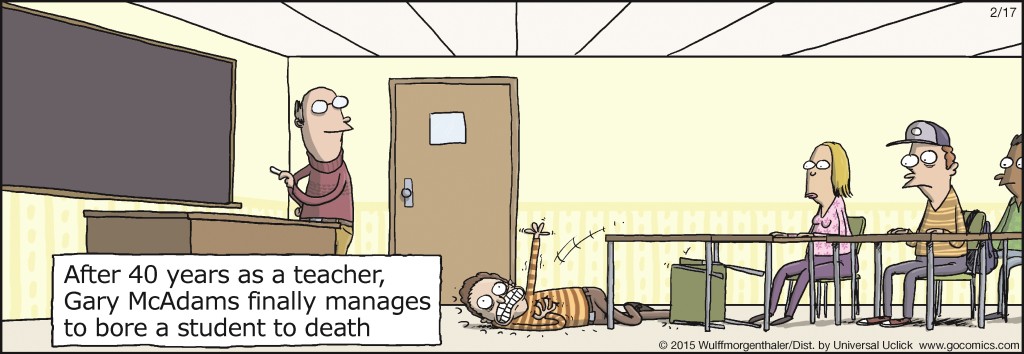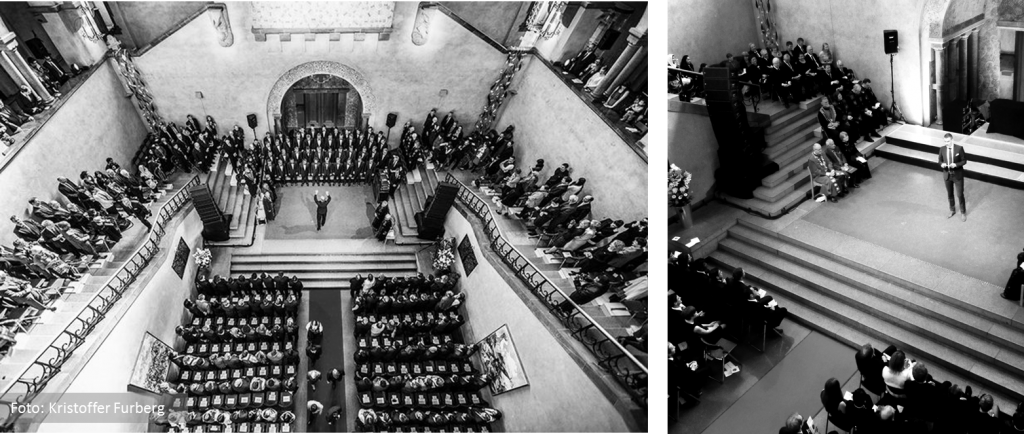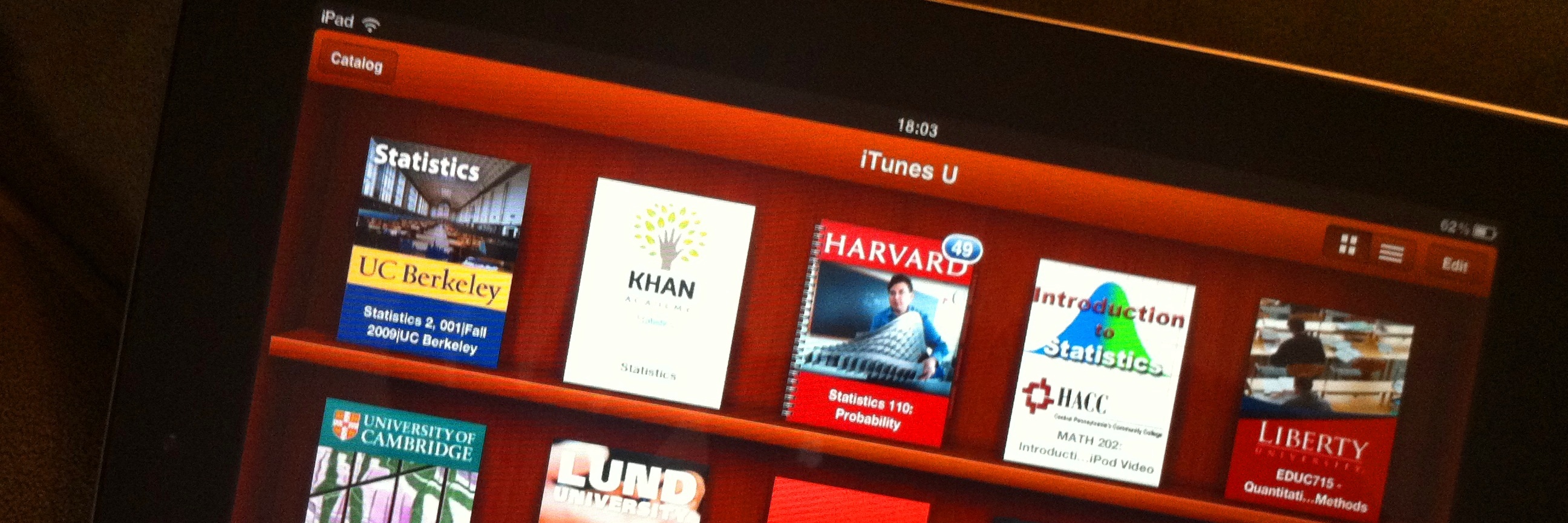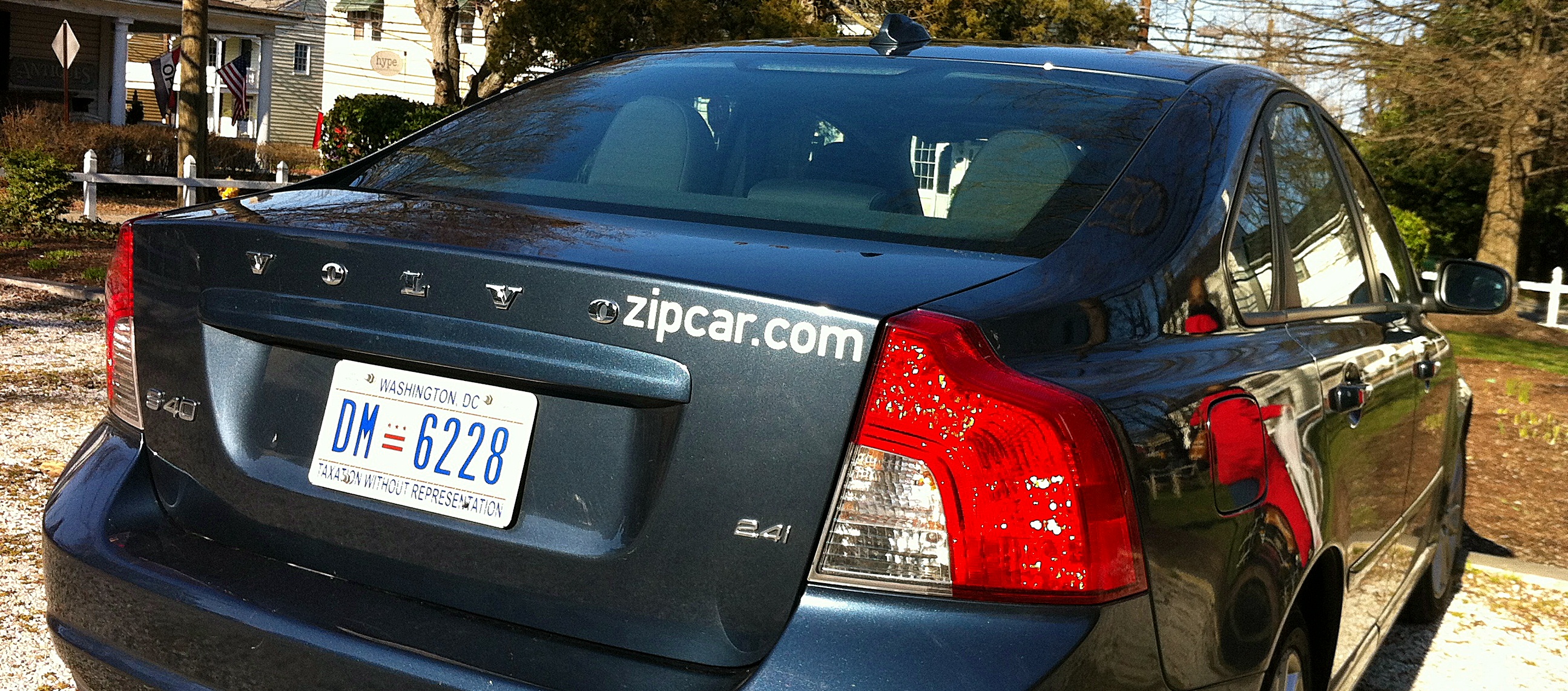The Routledge Companion to Lean Management has hit the book shelves. Here is a summary of its main conclusions. The key message? Any lean transformation—regardless of the sector and application area—is dependent on the three essential Ls of lean: Leadership for Long-term Learning.
Category Archives: Better society
Academic life explained by WuMO
Oh, you’re an “academic”… but what exactly are you doing? Among my favorite cartoonists are Mikael Wulff and Anders Morgenthaler, who together write WuMO. Here are eight handpicked WuMo cartoons that explain the essence of academic life. Enjoy!
Teaching

WuMo ©WulffMorgenthaler. Reprinted with permission of Universal Uclick. All rights reserved.
Lean in the primary school?
Do concepts from the assembly line at Toyota apply to the learning environment of children from six to twelve years? One pioneering school in Rogaland, Norway, shows how some elements of lean thinking can be successfully adapted to create better conditions for teaching and learning.
A Letter of Tribute to Fred Kavli
On this day, exactly one year ago, one great Norwegian passed: Fred Kavli (1927-2013) was an engineer, entrepreneur, leader and—most importantly—a philanthropist. On my way to work, whether it is here in Cambridge or home in Trondheim, I pass one of his many living legacies. In Trondheim, it would be the Kavli Institute for Systems Neuroscience at NTNU (with fresh Nobel Prize winners in Medicine). In Cambridge it is the Kavli Institute for Cosmology. Both these examples are beneficiaries of Kavli’s passion for science, and both perform high-risk, world-class research in their respective areas. Mr. Kavli certainly deserves a letter of tribute.
A speech from a PhD to fellow PhDs
The annual Doctoral Degree Awards Ceremony has just been ceremoniously arranged at the Norwegian University of Science and Technology (NTNU), in Trondheim. I got the great honor of giving the Fellow Speech to the 370 new Doctors of Philosophy (PhDs). This post is an excerpt of this speech. It is a call for PhDs—in any field—to use their hard-won knowledge to contribute to a better society.

Go Lean, get Green?
Good news*: your operations can reach excellence in both Lean and Green. But to hope for success you need to treat Lean and Green as interconnected strategies—not isolated projects. That tip is a key take away from the SMARTLOG seminar “Lean & Green? Yes please both” that we arranged at SINTEF in Trondheim this week. Leading academics and corporations** in Scandinavia were invited to share their latest experiences on the topic. Do Lean and Green go well together?
Colouring the country of black and white: Wadja Inc. in Saudi Arabia
I have just returned from an excellent visit to Saudi Arabia, researching the implementation of ‘lean production‘ in a successful multinational company that produces the world’s highest quality of paints and paint systems. Going there, I heard that Saudi Arabia would be totally different than anything I’ve visited before. It was, and it was not. This post is about how foreign companies contribute to Saudi’s wealth and development, and slowly improves women’s rights through cultural exchange and mutual understanding. These companies and their expats colour the ‘country of black and white’.
Three fishes for Uganda: why Africa struggles to industrialise
‘The pearl of Africa’, as Sir Churchill once called Uganda, has yet to enjoy a rapid economic growth. That’s a challenge that Uganda shares with the majority of African countries. Multiple reasons for the African growth inertia have been suggested; unstable political environments, low education levels and insufficient infrastructure are usual suspects. The main reason for the slow industrialisation of Uganda, however, is neither political nor economical, it is cultural. This week in Kampala, Dr. Peter Lating at Makerere University, explained me the Ugandan mindset with a brilliant—and reportedly true—story. The story deserves to be shared, and it goes like this:
Moods of Norway towards global transparency and happier people
This week, I drove through Nordfjord, one of the world’s most beautiful corners, on the Norwegian west coast. There—in the prosperous and peaceful countryside—problems in China’s and India’s factories seem far, far away. But they really aren’t. Nordfjord is home to several successful apparel companies: Ricco Vero, Skogstad, and Frislid, famous in Norway and beyond. However, the iconic Moods of Norway is the best known of all. After repeated pressure from consumers and a Norwegian NGO, Moods of Norway finally went public with a list of worldwide suppliers [1-3]. That’s a good start, but not enough! It is admirable that they want to make “happy clothes for happy people”—but do they want to make people happy?
Waving the flag for Swedish Manufacturing
The winter sport season has barely started as Norway’s victorious skier, Petter Northug, kicks off his mockery season of our neighbor to the east: Sweden. A few days ago, in the Cross Country World Cup in Gällivare, Sweden, Northug passed the finishing line first—before Sweden—and with a Swedish flag. As the anchorman in the Norwegian cross-country relay team, he made sure that Norway won over Sweden at their home ground once again—and took great care that they knew… At the same time, I spent my third week in Sweden this year. As a student of business, I know that Sweden is a world champion in a “sport” that isn’t publicly celebrated but matters thousand times more than cross-country skiing: Manufacturing!
The bus driver from Bangalore: Making chaos flow
Respect for the Bangalorian bus driver—who probably has the world’s toughest job. While I visit Volvo factories in Bangalore this week, I feel the pulse of a thriving city that literally bursts into the streets with all its energy. The traffic in India’s third largest city is straightforward d r e a d f u l. Continuous honking seems to be the most important trick to come ahead and stay alive. In this total chaos of noise, pollution, people and vehicles, I am surprised to find the traffic flowing surprisingly swiftly. How do the Bangalorians create flow of mere chaos?
MIT DIY at iTunes University
Ever wanted to follow courses at the Massachusetts Institute of Technology (MIT)? Harvard? Or, if you prefer, the University of Cambridge, Oxford, Yale, Berkeley, Georgetown, University of Tokyo, or the Norwegian University of Science and Technology? Well, you can. It is free and you can easily Do-It-Yourself (DIY). Why not MIT DIY? … Here’s how I used iTunes University and YouTube to substantially improve my statistics skills over a few weeks.

Public transportation that works: The Curitiba Case
Cities all over the world strive to improve their public transport system. The benefits of a faster, more reliable and more effective bus transportation system is obvious; both to users and the environment. Why is public transport then often so extremely badly planned, expensive and unreliable? Curitiba in Southern Brazil offers their solution to the challenge. In fact, in such a way that the city is well-known to city planners worldwide. What has Curitiba done?
ZipCar: Car sharing for the future
I have two Volvo S40, two BMW 328xi, a Toyota Tacoma Pickup, a Cooper Mini, a Mazda 3, a KIA Soul, and a Ford Escape in my garage. Best of all; I pay less that $20 a year to get access all of them as much as I want. They get washed and cleaned, and I never bother about repairs or maintenance. I pay for use and don’t even worry about gas prices or toll stations. I’m a Zipster by ZipCar. You can be one too!

My car this weekend – Volvo S40 from ZipCar (c)tnetland
Let Freedom Ring
Yesterday, Barack and Michelle Obama spent the evening like I did; attending the Georgetown University’s amazing “Let Freedom Ring” concert in honor of Martin Luther King Jr. at the Kennedy Center.
Ben & Jerry’s: Top 14 ice creams from a peculiar company
OK, I gladly admit; this post is more a fun post than a discipline post in operations management… Just like the products from Ben & Jerry’s are much more fun than many other manufactured products. Here’s my list of 14 favorites (yes, they are all favorites). Which is yours?

Photo: Ben & Jerry’s pints of fun: No. 9, No. 11 and No. 5 of 14 tested flavors
Philadelphia – once the workshop of the world
A magnificent city skyline arises behind a white wall of damp from factory pipes as we drive into Philadelphia. Factories, ship yards and terminals as far as the eye can see. Still, it soon becomes clear that many pipes stand tall but idle; no white damp escapes them anymore. Philly – once named “the Workshop of the World” [1,2] – is standing in a rising shadow of its closed down factories. Why?
Pinnekjøtt – made in the USA
It’s here. The most important ingredient of a real Norwegian West Coast Christmas celebration arrived timely to our Washington DC apartment today: Pinnekjøtt. Cured lamb meat ready for cooking and the taste of Christmas Eve. Big thanks to Willy’s Products in Florida (!) for producing and shipping this delicacy in the US (with certain reservations… it remains to enjoy it the 24th:). Norwegian pinnekjøtt – made in the USA.
7.000.000.000 people to serve: What does this mean for manufacturing industries?
Today we turned 7 billion people on the earth. When I grew up in the 1980s, I remember we talked about turning 5 billion people. A magical number that made us learn about the world population in several weeks in school; discussing and drawing more or less successful children sketches of our multi-cultural and common world. My father has seen the world population triple fold in his life time; In 1940 there were 2,3 billion world citizens according to UN. UN estimates that the growth rate will now decline some, but still we will probably turn 9 billion people in 2050. What does these figures imply for manufacturing industries worldwide?
The Coupon Society
Have you seen any coupons lately? Of course, you have. They are everywhere. In the US we live in a Coupon Society. I undertook a brief investigation into the amount of coupons in our daily lives by counting the number of coupons in today’s Washington Post. Here is why we should end this paradigm.
A stone of hope
On a wonderful and sunny Sunday morning, thousands enjoyed the opening ceremony of the Martin Luther King Jr. (MLK) Memorial in D.C: A stone of hope. MLK was a drum-major for change in his time. Are we now living MLK’s 1963 dream speech? [The following quotes are paraphrases of the speeches]
Wall Street v.2.0 – no greed, no envy
The Occupy Wall Street campaign is legitimate. As long as the nonviolence policy of the movement sustains, their voices deserves to be heard and political actions should be taken to oblige their cause. They claim to represent 99 % of the people, fighting the ever-growing gap between the richest and the rest. Liberty and justice for all – who does not support that?
No country can afford wasting its human resources
These times are troubled times for the global economy and the United States. In the US, the main challenge is neither greedy banks nor competition from China, but the underlying fear that prevails the society and economy. This country is built on everything but fear; bravery, boldness, passion, and energy. What Franklin D. Roosevelt, almost 80 years ago, depicted as a worst-case scenario is nevertheless sneaking into the minds of Americans: “The only thing we have to fear is fear itself” (FDR, 1932). The most important job of the American Jobs Act is to remove fear. A sustainable way to remove fear is to provide people with good and secure jobs.
Child chooses love at MLK Memorial in D.C.
"Darkness cannot drive out darkness; only light can do that. Hate cannot drive out hate; only love can do that." (Martin Luther King, 1963, Strength to Love)
Apply this truth in your organization as well as in your life.
